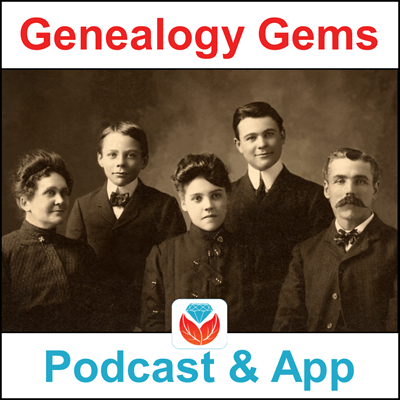Genealogy Gems Podcast Episode Show Notes
The Genealogy Gems Podcast helps you make the most of your family history research time by providing quick and easy-to-use research techniques. Producer and host Lisa Louise Cooke brings you the best websites, best practices, and best resources available. This podcast is 100% free! Just click an episode below to start listening right now. Click here to get our app.
New to the free Genealogy Gems Podcast?
Frequently Asked Questions
Recent Episodes:
Episode 282
Newspaper research and obituaries.
Episode 281
Find and Identify Old Photos at DeadFred.
Episode 280
16 Ways to Find Your Ancestors’ Village.
Episode 279
Resolving Conflicting Birthdates, plus DNA Painter with Blaine Bettinger.
Episode 278
Should you use ChatGPT or Bard for genealogy research?
Episode 277
Marriage Case Study with J Mark Lowe and Researching Witnesses with Robyn Smith
Episode 276
Free Old Newspapers at Google Books
Episode 275
Restarting Your Genealogy Research
Episode 274
Marriage Records and Gretna Green
Episode 273
GEDCOM Files
Episode 272
15 Genealogy Freebies
Episode 271
Source Citations
Episode 270
Pennsylvania and Ohio Genealogy
Episode 269
Virginia genealogy strategies and best websites
Episode 268
Using Newspapers to Reconstruct an Ancestor’s Story
Episode 267
How to Become a Forensic Genealogist
Episode 266
Dealing with inherited genealogy
Episode 265
Writing and Publishing a Family History Book with author J.M. Phillips
Episode 264
1890 Census Substitutes
Episode 263
1950 census indexing update
Episode 262
Lisa’s Genealogy Data Workflow
Episode 261
10 Top Tips for German Research with Katherine Schober
Episode 260
Your Guide and UPDATE to the 1950 US Federal Census.
Episode 259
Very special audio version of New York Times best-selling author Tom Hegg reading his beloved Christmas stories set to the beautiful music of the season.
Episode 258
Strategies for solving genealogical problems with DNA. Guest: Sara Allen.
Episode 257
The top 10 types of genealogy content you can find for free at the Internet Archive.
Episode 256
Interview with Nathan Dylan Goodwin, author of the Chester Creek Murders and The Sterling Affair.
Episode 255
How to find genealogy with the National Archives Online Catalog.
Episode 254
How to use Google Photos for family history.
Episode 253
How to find early American ancestors in New England. Special Guest: Lindsay Fulton, NEHGS and AmericanAncestors.org.
Episode 252
How to find family history related photos and images in old newspapers with Newspaper Navigator.
Episode 251
Free genealogy records online at the Allen County Public Library Genealogy Center website.
Episode 250
10 Surprising Genealogy Things You Can Find at Google Books.
Episode 249
10 questions you must ask for genealogy research success.
Episode 248
Free Genealogy!
Episode 247
Filling in the blanks after a genealogy consultation.
Episode 246
How to tell your easily create family history videos for free with Adobe Spark Video.
Episode 245
How to tell your family history story with video. Special guest: Kathy Nielsen.
Episode 244
Ancestry Search Tips.
Episode 243
One Family’s Story: Lessons Learned from History. My special guest is Daniel Horowitz, Genealogy Expert at MyHeritage.
Episode 242
The importance of genealogy research questions and plans. Plus how to avoid research distractions.
Episode 241
Update to Google Search, How to reunite found items to their families, and 10 strategies for finding school records.
Episode 240
In this episode you’ll hear from genealogy experts on genealogical evidence & Proof, DNA, and organization.
Episode 239
Award-winning journalist Libby Copeland, author of the new book The Lost Family: How DNA Testing is Upending Who We Are discusses how DNA testing has changed our world.
Episode 238
Do you love genealogy, mysteries and puzzle solving? Well in this episode we have not one but two tales of mystery. The first has a Valentine’s theme centered around a mysterious love letter. Professional genealogist Kathleen Ackerman will be here to share how a love letter that was missing its last page took her on a genealogical journey full of surprises. Our second story is the mystery of a lost family scrapbook. It’s full of twists, turns and murder!
Episode 237
Interview with Andy McCarthy, Genealogy Reference Librarian on the New York Public Library’s Genealogy Collections. Also, David Fryxell, author of a new book on Scandinavian Genealogy.
Episode 236
Interview with David Lowe, Specialist for the Photography Collection at the New York Public Library on a free tool they provide that can help you identify your old photos. Also a discussion of how to find unindexed records at Ancestry.com.
Episode 235
Federal Court Records with professional forensic genealogists Michael Strauss. You’ll learn the history of federal records, where they are housed, and how you can search for them and access them. You’ll also hear about real examples of federal court records used for genealogical research. Don’t miss the show notes!
Episode 234
In this episode we take a look at a subject that is difficult, and yet ultimately faced by all genealogists: Downsizing. Whether you need to help a relative downsize, or it’s time for you to move into a smaller place or just carve out more room in your existing home, this episode is for you. You’ll hear specific action steps that you can follow to the make the job of downsizing easier and more productive. Also in this episode we’ll cover the latest genealogy news, and take a quick look at the 1830 census.
Episode 233
Professional genealogist Cari Taplin joins me for a conversation about the power lists and why careful examination is so important. Also: what I did on my summer vacation, the Gregorian Calendar, and the new MyHeritage Education Center (where you can also watch my presentation from the MyHeritage LIVE conference held in Oslo, Norway.)
Episode 232
Exploring what you can do to go deeper in your genealogy research for a more accurate family tree with Elissa Scalise Powell. Irish genealogy radio host Lorna Moloney, a professional genealogist with Merriman Research, discusses Irish genealogy.
Episode 231
We start off with tech news about Google Earth, FamilySearch and MyHeritage. Then we dig deep into the genealogical research Julianne Mangin did for “Alice’s Story.”
Episode 230
The story of Roy Thran and how his short life story is impacting lives today. Author Karen Dustman discusses writing your memoir. Lisa shares her adventures in England.
Episode 229
Two listeners shares an exciting find using Lisa’s research strategies. Lisa provides next steps on German research in response to a listener question. Your Master Family Tree, and Sharing Branches Online Explained. The unusual history of one of the earliest forms of the World Wide Web
Episode 228
More new feature enhancements announced by Ancestry.com; Listeners share their stories; Interview with Crista Cowan, The Barefoot Genealogist at Ancestry.com; 3 intriguing discoveries made while searching cemeteries; Women’s registration cards on the home front from 1917-1918 during World War I; RootsTech Film Festival semi-finalist Sydney Orton shares the touching story behind newly discovered precious audio and video tape, and how she and her sister honor their grandparent’s memories.
Episode 227
The biggest announcements coming out of RootsTech 2019, and an in depth interview with Ran Snir, Product Manager at MyHeritage DNA on The Theory of Family Relativity™ and Auto Clusters.
Episode 226
Research strategies and new resources, the history of your ancestors’ baby clothing, a tech tip that protects you, and the key to deciphering draft registration cards.
Episode 225
Get ready for a fun and inspiring start to your new genealogy year. In this episode, I’m going to bring you a talented lady who’s a sharp genealogist and just happens to be one of the hosts of the television series Genealogy Roadshow, Kenyatta Berry.
Episode 224
In this episode, we recap 2018, and explore additional ideas to help you organize your home movies. Whether you have 8MM film, VHS tapes, Mini DV tapes or DVDs, this episode has what you need to preserve and organize them.
Episode 223
We explore the notion that we are all just bit player’s in everyone else’s show, and how that could lead to video genealogical gold. David Haas MD shares his family’s history of filming home movies, and the tremendous impact they’ve had on countless other families. You’ll learn how to digitize and share your home movies too.
Episode 222
It’s family history month and who better to dedicate this episode to than you! You’ll hear from many of our wonderful listeners who share opinions, research strategies and more. Also, you’ll hear about the exciting new genealogy conference that will be held in Birmingham, England in 2019: THE Genealogy Show.
Episode 221
Lisa talks about vital records with Shannon Combs-Bennett and welcomes a drop-by guest, Daniel Horowitz of MyHeritage.com, a great new resource from Library & Archives Canada; an update from Your DNA Guide Diahan Southard on MyHeritage DNA tools; and the long-awaited conclusion of Project Lizzie.
Episode 220
An exclusive tip from one of two major upcoming genealogy events; Fun travel suggestion from The Archive Lady Melissa Barker: “Archive in a backpack”; DNA specificity from Your DNA Guide Diahan Southard; Finding books about your ancestors’ experiences and Finding your German ancestor’s place of origin.
Episode 219: Lisa shares the stories of longtime researcher, librarian, and blogger Julianne Mangin, who has explored the tragic and twisted stories of her ancestors. The stories alone are worth the listen–but for Lisa, the real intrigue and inspiration comes from how Julianne shed light on confusing and contradictory records by finding news accounts that helped explain them.
Episode 218
Lisa Louise Cooke answers your questions and shares your comments. Hot topics on your minds that are covered in this episode include discovering new records online, best practices for working with other people’s online trees, hard-to-locate military records, and early Pennsylvania research with James Beidler.
Episode 217
Spend a thought-provoking hour with Lisa as she explores the Golden State Killer case and the investigator’s use of genetic genealogy websites, and the questions that it raises. Get ready for a deep dive into the questions we face, the reality of the current DNA environment, and what it all means for you.
Episode 216
Lisa shares her experiences at Rootstech and in Australia; an interview with Findmypast CEO Tamsin Todd and executive Ben Bennett; women who have served in the military, and how to use the new MyHeritage chromosome browser.
Episode 215
Blast from the Past: Family History and Silent Movies. An interview with Sam Gill former Archivist for the Academy of Motion Picture Arts & Sciences.
Episode 214
Irish expert Donna Moughty joins Lisa to talk about Irish genealogy, helping you get a jump on yours before everyone starts talking about their Irish roots on St. Patrick’s Day next month! Your DNA Guide Diahan Southard has DNA news. Also: Listeners write in with inspiring successes and Michael Strauss musters in with tips on finding your ancestors in the five branches of the U.S. military.
Episode 213
Lisa shares a moving family history video, inspired by a listener’s “Where I’m From” poem. Hear the latest RootsTech news and an excerpt from an interview with author Sylvia Brown. Military Minutes contributor Michael Strauss explains the difference between different kinds of military service: regulars, volunteers and militia in Military Minutes.
Episode 212
Lisa talks with Sunny Morton about turning your fleeting memories into meaningful stories. Diahan Southard takes a look back at DNA advances in 2017. Finding missing ancestors: tips and success stories from Genealogy Gems fans. Ancestor found in a patent using Google Books. And Lisa shares Margaret Linford’s reflections on her “Genealogy Origins.” App Bonus: The history of Mince Pie at Christmas. Yum!
Episode 211
Ellis Island historian Barry Moreno shares the stories of workers at the leading U.S. immigration station (1892-1954). Two listeners write in about rescuing old artifacts and returning them “home;” the National Archives Citizen Archivist and British Library map geo-tagging projects; and Official Military Personnel Files for 20th-century US servicemen and women (hear what Michael Strauss found in his grandfather’s file).
Episode 210
Researching in a “burned city” (Chicago); the latest buzz and opinions about DNA health reports you can get with your DNA tests for family history; news from the Genealogy Gems Book Club; get-started Swedish genealogy tips from Legacy Tree Genealogist Paul Woodbury; accessing unprocessed archival records; and, five years away from the release of the 1950 US census, Lisa has tips on preparing for its release and researching your family in the 1940s.
Episode 209
David Ouimette of FamilySearch is known to his colleagues as “the Indiana Jones of genealogy” because of his globe-trotting adventures in curating record treasures. He joins us to talk about the millions of records being digitized around the world right now. Plus ,lots of excited emails from you, compiled military service records from Military Minutes expert Michael Strauss, and an historic newspaper Gem!
Episode 208
Hear the inspiring story of a genealogy hero who saved a life story–and a community’s history. Lisa shares an inspiring Google Books success story; how one listener gets her shy husband talking about his life story; and a listener’s “Where I’m From” poem. Learn tips for getting started in Swedish genealogy, using historical scrapbooks at archives, watching Lisa and Diahan’s new free webinar and getting ready for RootsTech 2018.
Episode 207
Lisa welcomes Mary Tedesco, a co-host of PBS’ Genealogy Roadshow. Mary shares stories and tips about tracing Italian and Italian-American roots. Also: FamilySearch updates since the end of microfilm lending (and how YOU helped make the last days of lending more effective); A listener uses Google to find her mysterious great-grandmother, with a success story she calls a “game-changer” for her genealogy research. And the premiere of Military Minutes with Michael Strauss.
Episode 206
In this Blast from the Past episode Lisa reprises a favorite research detour into vehicle forensics to identify an old family car and shares tips for creating short family history books like those she given as holiday gifts to loved ones. Hear letters from listeners on a special adoption discovery and a 1940 census mystery that now makes more sense. Your DNA Guide Diahan Southard weighs in with 4 reasons to take a DNA test, if you haven’t taken the plunge yet. Genealogy Gems Editor Sunny Morton spotlights the current Genealogy Gems Book Club title, Murder in Matera. The vehicle forensics and family book segments originally appeared in Genealogy Gems Podcast episodes 18 and 13, respectively, and are being republished here for web audiences.
Episode 205
This double-header episode pairs two interviews and two huge pieces of industry news! Hear about the end of FamilySearch microfilm lending and how you can get the records you need. Get the scoop on the game-changing addition to RootsMagic: your Ancestry.com tree now syncs with the software! Melissa Barker shares tips on preserving heirlooms and visiting archives. Nicole Dyer shares a fun family history activity idea to do with kids—do you have a family gathering coming up that could use this inspiration?
Episode 204
Dave Obee returns with a poignant story about the Canadian Home Children and tips for newspaper research. Also: a new Catalog and improved DNA ethnicity analysis at MyHeritage (it’s free—upload your DNA!); an excerpt from the Genealogy Gems Book Club interview with Fannie Flagg; a detailed get-started for British Isles research; and why so many weddings are traditionally held in June.
Episode 203
Renowned Canadian expert Dave Obee shares his favorite tips on researching the Canadian census—his insights are fascinating whether you have Canadian ancestors or not! Also: an inspiring adoption discovery, DNA testing news at 23andMe, the newly-updated Atlas for Historical County Boundaries, a tip for incorporating family history into a wedding, and a brand-new resource that can finally help you solve one of genealogy’s most perplexing questions.
Episode 202
Breaking news in this episode! Learn about AncestryDNA’s new Genetic Communities straight from Catherine Ball, Ancestry’s Chief Scientific Officer. This breakthrough helps us use DNA to follow family migration patterns. You’ll also Relative Race contestant Joe Greer and hear about the new Genealogy Gems Book Club featured title. Naming traditions tip from a listener can help you puzzle out ancestral pedigrees. And watch for a few great Google search strategies for genealogy.
Episode 201
Lisa chats with Angela Walton-Raji, expert in U.S. and African-American research, about tips for interviewing relatives and taking your African-American family tree back to the era of slavery; A RootsTech 2017 recap, with info on archived streaming sessions; Great news from Findmypast about its new Catholic Heritage Archive; A ground-breaking study from AncestryDNA that identifies specific migration patterns among genetically-related clusters of people; Follow-up mail from Lisa’s Episode 200 celebration; An expert Q&A on finding relatives who don’t appear in the census where you expect them to; A teaser clip from the upcoming Genealogy Gems Book Club interview with Annie Barrows, author of The Truth According to Us.
Episode 200
Our 200th episode and 10th anniversary episode!
Episode 199
A celebration of Canada’s 150th birthday with Lisa Louise Cooke’s interview with Claire Banton of Library and Archives Canada; DNA Testing with Kids; the announcement of the new title for the Genealogy Gems Book Club 1st quarter 2017; the awesome discovery made on YouTube by a listener; a new social networking platform for families called Famicity; Rootstech 2017.
Episode 198
Lisa Louise Cooke welcomes Genealogy Gems Book Club author and Victorian lifestyle expert Sarah Chrisman to the show to talk about Victorian holiday traditions, some of which may still live on in your own life. Following that conversation, Lisa shares a fun description of Victorian-era scrap-booking: how it’s different than today’s scrap-booking hobby but also how it reminds her of modern social media. Also: Three success stories from Genealogy Gems listeners: a Google search with great results, a brick-wall busting marriage record and yet another YouTube find for family history (people keep telling us about those!). Your DNA Guide Diahan Southard chimes in with what she likes so far about MyHeritage’s new DNA testing service. An internationally-themed German research conference and a makeover for the Scotland’s People website.
Episode 197
A chat between Lisa and Genealogy Gems editor and author of the book Story of Your Life Sunny Morton discuss the value and importance of telling your own story. A reading by Genealogy Gems Book Club featured author and Victorian lifestyle expert Sarah Chrisman. Your DNA Guide Diahan Southard discusses the next steps for your DNA results. Lisa walks a listener through several tips for learning more about her immigrant ancestors, and shows how to use today’s technology tools to help with traditional research skills. A spotlight on new marriage records online for the U.S. and around the world.
Episode 196
Professional genealogist Kate Eakman from Legacy Tree Genealogists shares tips and resources for those tracing their Irish ancestors into Ireland, and answers all your questions about how to hire a professional genealogist. Plus, we have an exclusive $100 discount code for you! Also in this episode: opinions on sharing gossip about our ancestors; new Genealogy Gems Book Club book announced and a past featured author has a new book out; big genealogy conferences in 2017; and organize your DNA test results and matches to help you get the most out of them.
Episode 195
This month, we’re celebrating the 100th episode of The Family Tree Magazine Podcast with one of my favorite segments on shaping up your research, and the 2 millionth download of the Genealogy Gems Podcast. Lisa Alzo gives us the back story on Czech records that have recently come online; and a YouTube search success story. You’ll also hear highlights of the Genealogy Gems Book Club interview with Chris Cleave, author of Everyone Brave is Forgiven, and our DNA correspondent Diahan Southard will discuss Gedmatch, a free resource you might be ready for if you’ve done some DNA testing.
Episode 194
This blast from the past episode comes from the digitally remastered Genealogy Gems Podcast episodes 11 and 12 (originally recorded in 2007). They are now interwoven with fresh narration and updated show notes. Topics include: Google Images; Top 10 Tips for finding Graduation Gems in your family history; Display your family history with an easy to create Decoupage plate.
Episode 193
Genealogy milestones, anniversaries, new records, upcoming conferences and new free video tutorials; Email response to episode #192: another tip on the U.S. Public Records Index, a family adoption story and his own research on the changing coastline of Sussex; More response to the “Where I’m From” poetry initiative; The NEW Genealogy Gems Book Club title is announced; A key principle in genetic genealogy.
Episode 192
Lisa shares a favorite new super easy-to-use tool for turning family photographs into captivating professional-looking videos and slideshows that you can share. Then you’ll meet the newest member of the Genealogy Gems team, Amie Bowser Tennant who shares insights into becoming a certified genealogist. A Gem shares a tip about a favorite genealogy database. An inspiring story of adoption and DNA, and a delightful excerpt from the Genealogy Gems Book Club interview with Helen Simonson on The Summer Before the War.
Episode 191
Diahan gets us up to date on the changes at Ancestry DNA; Thom shares his success using Google Earth for Genealogy; Jim Beidler talks about new Germany records at FamilySearch, Amy Johnson Crow shares her favorite local history apps; Sunny shares her thoughts on our Book Club featured book.
Episode 190
Extreme Genes radio show Scott Fisher talks about his role in helping to solve a 30-year old missing persons case; Lisa advises a listener on a pesky Gmail problem; A whirlwind world tour of new genealogy records online; Searching out military service details with Google Books; One RootsTech attendee’s Google search success story; the new Genealogy Gems Book Club title, a brand-new, much-anticipated second novel by a breakout British novelist.
Episode 189
Visit with the Wrights, a couple for Alaska, who star in the new genealogy TV series Relative Race. Plus: Irish research tips, 3 very good reasons for testing your DNA for genealogy, and an excerpt from our Genealogy Gems Book Club interview with the author of Orchard House
Episode 188
RootsTech news and resources for everyone; New records online for Ireland and the United States; Two inspiring emails from listeners who unravel family mysteries with determination, skill and Google sleuthing; A Genealogy Gems Book Club update with more thoughts on the featured title Orchard House: How a Neglected Garden Taught One Family to Grow by Tara Austen Weaver and book recommendations from RootsTech attendees; A critique of a recent NPR article on genetic genealogy by Your DNA Guide Diahan Southard; and a great conversation with Cindy Cochran and Sabrina Riley of the Lincoln-Lancaster County Genealogical Society Library at Union College in Lincoln, Nebraska.
Episode 187
Lisa welcomes the Legal Genealogist Judy Russell to the podcast. Judy takes on a Genealogy Gems listener’s fantastic question about the bounty land his War of 1812 ancestor never claimed. Also in this episode: Life after Family Tree Maker software, New strategies for using Google to answer your genealogical research questions, the new Genealogy Gems Book Club title,and all about the upcoming RootsTech 2016 genealogy conference.
Episode 186
Celebrate upcoming holiday family time with a special segment on interviewing relatives. Diahan Southard offers her thanks for DNA connections that are helping fill holes left by adoption. We’ll cover a new resource from MyHeritage for connecting with other researchers, family history poetry from two Gems listeners, letters from the Gems mailbox, and an excerpt from our new Genealogy Gems Book Club interview with Lalita Tademy (which appears in full in Genealogy Gems Premium podcast episode 130..
Episode 185
Genealogy Gems is celebrating reaching a milestone: 1000 genealogy-filled blog posts on our website! But we’re not just celebrating our own genealogy writing. We’re celebrating YOURS! In this episode we celebrate what you have shared with us about your adventures in family history blogging. I also have a short, fun family history writing challenge to share with everyone, not just those who blog, a writing contest, and the poet laureate of Kentucky.
Episode 184
Listeners thoughts on saving your genealogy from theft and a tip on digital preservation. I share An Open Letter to Grandma, and Sunny will join me to announce our next Genealogy Gems Book Club pick—and we may or may not digress a little to talk about other fun things on our minds. And Diahan will discus “empty-handed genealogists” and their DNA.
Episode 183
A digital expert joins us to talk about digitizing and storing your old movies, videos, and pictures. You’ll hear a juicy clip from our exclusive Genealogy Gems Book Club interview with Pamela Smith Hill, the editor of the new Laura Ingalls Wilder biography, Pioneer Girl. And Your DNA Guide is here with a story of DNA and President Harding.
Episode 182
In the summer of 1944, a handpicked group of young GIs landed in France to conduct a secret mission. They were to create an elaborate façade of military might for an audience, the German army. These 1100 men had one goal: to fool the enemy into believing they were an American army thousands strong, and draw their attention away from the actual fighting troops. Get ready to go behind the curtain of Twenty-third Headquarters Special Troops known as the Ghost Army with my special guest Rick Beyer, author of the book The Ghost Army of World War II: How One Top-Secret Unit Deceived the Enemy with Inflatable Tanks, Sound Effects, and Other Audacious Fakery
Episode 181
Researching your family in the 1950s, introduction to the 3rd Quarter 2015 Genealogy Gems Book Club featured book, a new patent by Google for an innovative solution, two new record collections online that fill in a hole in American documentary history, and email from listeners about the new Ancestry site and family history blogging.
Episode 180
Changes at Ancestry, books at FamilySearch, Canadian research, Google’s new device, getting the most from a trip to the state archives, Military records for sailors, Integrating Genetics and Genealogical Tools, Interview with Nathan Dylan Goodwin author of The Lost Ancestor.
Episode 179
In this episode I’ll share inspirational story from listener Helen, and another amazing story about an adoption reunion. And we’ll check in with our Genealogy Gems Book Club Guru Sunny Morton about this quarter’s featured book, The Lost Ancestor by Nathan Dylan Goodwin. And of course all kinds of other genealogy news and tips for you.
Episode 178
Niche record collections that might just be what you are looking for. Interview with genetic genealogist CeCe Moore about using DNA for genealogy research, adoption, and the Finding Your Roots TV show. Announcement of the Genealogy Gems Book Club book for the 2nd quarter of 2015. A listener shares an update on adoption records in Ohio.
Episode 177
This episode features part of our interview with Christina Baker Kline, the author of our Genealogy Gems Book Club featured book Orphan Train. The book spent five weeks at the #1 spot on the New York Times Bestselling list as well as time at the top of The Bestsellers List in Canada, and by now after reading the book you know why. Christina will share how the book came in to being. And why she first hesitated to write it. And how, although this is a novel, in fact the details of Vivian’s story are true thanks to her extensive research. And Christina sheds light on the effect that being an orphan had on the children of yesterday and the children of today.
Episode 176
Get a Round Up of RootsTech Round, join Genealogy Gems Book Club Guru Sunny Morton for more on our featured book Orphan Train, and some additional books you’ll want to add to your reading list that also provide insight in to how you can approach writing your own family’s history. Then Your DNA Guide here at Genealogy Gems, Diahan Southard, shares how to Social Network Your YDNA with Surname Projects.
Episode 175
Genealogy Gems Contributing Editor Sunny Morton announces our new Book Club read for this first quarter of 2015. Then, professional genealogist Mary Tedesco from the Genealogy Roadshow television series will join Lisa to talk about her experience on the show and also about her specialty which is Italian research. Our Genealogy Gems DNA Guide will also be here. And we wrap with a very special announcement at the end of the show.
Archived Episodes
Season 9 – Episodes 161 – 174 (2013 – 2014)
Season 8 – Episodes 141 – 160 (2012 – 2013)
Season 7 – Episodes 121 – 140 (2011 – 2012)
Season 6 – Episodes 101 – 120 (2010 – 2011)
Season 5 – Episodes 81 – 100 (2010)
Season 4 – Episodes 61 – 80 (2009 – 2010)
Season 3 – Episodes 41 – 60 (2008 – 2009)
Season 2 – Episodes 21 – 40 (2007- 2008)
You’ll also love all the expert interviews that make the Genealogy Gems Podcast your own personal genealogy conference: Dick Eastman, DearMYRTLE, Curt Witcher, CeCe Moore, Arlene Eakle, the folks from Ancestry.com and celebrities such as Lisa Kudrow of Who Do You Think You Are?, Mary Tedesco of Genealogy Roadshow, Tukufu Zuberi of The History Detectives, Kathy Lennon of the Lennon Sisters, Tim Russell of Garrison Keillor’s A Prairie Home Companion, and Darby Hinton of the Daniel Boone TV series from the 1960s.
Season 1 – Episode 1 – 20
The originals shows are no longer available in the iTunes feed. Episodes are being remastered and are being rebroadcast in current episodes as follows:
Episode 1 & 2 remastered and published in episode 134
Episode 3 & 4 remastered and published in episode 140
Episode 5 & 6 remastered and published in episode 145
Episode 7 & 8 remastered and published in episode 149
Episode 10 remastered and published in episode 153
Episode 11 & 12 remastered and published in episode 194
Episode 13 remastered and published in episode 206
Episode 14 remastered and published in episode 215
Episode 18 remastered and published in episode 206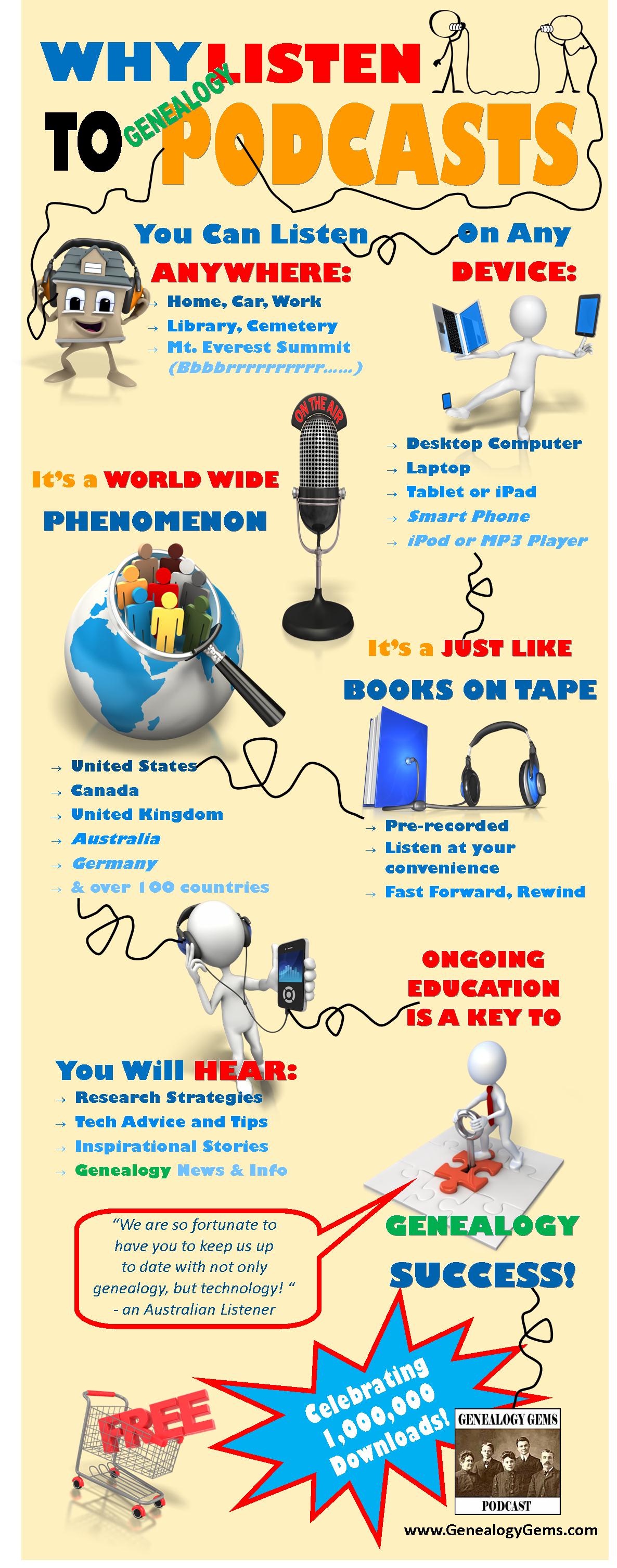
Genealogy & Family Tree Video Classes
Choose from our vast catalog of free and Premium genealogy video classes and tutorials. Start by selecting a topic below. Tip: On desktop use Ctrl F (Win) or Cmd F (Mac) to search the entire list of videos by keyword. Note: The search box and Categories menu on the right (desktop) or the bottom of the page (mobile) apply to audio podcast episodes and articles.
Videos marked “Premium” require a Premium Membership. Premium Members also have access to the downloadable ad-free show notes handout for all videos.
Beginner
Home Research – Family History at Home
15 Freebies for Genealogy
Free Genealogy
Inherited Genealogy – How to Deal with It
Data Flow for Genealogy
Getting Started with DNA Testing (Premium)
Google.com Getting Better Search Results (Premium)
Evernote for Genealogy – Beginner
FamilySearch Strategy Essentials
FamilySearch Wiki Navigation
Take Control of Preserving Your Family History Information (Premium)
RETURN TO TOP OF PAGE
DNA
5 Tips for Understanding DNA Results with Diahan Southard (Premium)
Autosomal DNA Results: Make the Most of Them with Diahan Southard (Premium)
DNA: Glue that Holds Families Together with Diahan Southard (Premium)
DNA Match with No Tree? No Problem! (Premium)
DNA Problem Solving
DNA Q&A with Ancestry’s Crista Cowan
DNA Painter Quick review with Blaine Bettinger
Forensic Genealogist – How to Become One with Dr. Claire Glen
Forensic Genealogy Future and Phenotyping (Premium)
Gedmatch Shared Matches Tool with Diahan Southard (Premium)
Getting Started with DNA Testing with Diahan Southard (Premium)
Organizing Your DNA Matches with Diahan Southard (Premium)
Mitochondrial DNA Quick Introduction with Diahan Southard (Premium)
Mitochondrial DNA Match Page Quick Overview with Diahan Southard (Premium)
MyHeritage DNA Genetic Groups
MyHeritage DNA Results: Get the Most Out of Them (Premium)
YDNA Quick Introduction with Diahan Southard (Premium)
YDNA Haplogroups Quick Overview with Diahan Southard (Premium)
Become a Premium Member
RETURN TO TOP OF PAGE
Elevenses with Lisa (2020: The 1st Year)
Note: Elevenses videos beyond the 1st year are included under the various topics on this page.
- Pilot (Premium)
- Research Plan (Premium)
- BSO Strategies (Premium)
- Mobile Organization (Premium)
- Online Organization
- Organization Paper (Premium)
- Organizing Data Q-A (Premium)
- Organize Digital (Premium)
- Evernote (Premium)
- Saving Your Genealogy from Destruction (Premium)
- Inspiring Ways to Captivate Non-Genealogists (Premium)
- Google Earth (Premium)
- Google Search – Get Better Results (Premium)
- Creating Family History Videos (Premium)
- Learning from History (Premium)
- Using Adobe Spark Video (Premium)
- Ancestry Top Tips (Premium)
- Irish Genealogy Professional Consultation (Premium)
- Filling Blanks in Your Research (Premium)
- House History
- Free Genealogy
- Your Ancestor’s Neighborhood (Premium)
- Google Photos
- Your Online Mindset (Premium)
- Elevenses with Lisa Viewers Voices (Premium)
- Newspaper Navigator and the Library of Congress
- Google Lens for Genealogy
- House Photo ID
- Family Bible
- Google Books
- Allen County Genealogy Center
- Artificial Intelligence
- Early American Genealogy (New England)
- Passenger lists
- Viewer Voices 2 (Premium)
- Rumsey Maps
- Provenance of Records
- A Cup of Christmas Tea with Tom Hegg (Dec 2020)
Ethnicities
German Genealogy for Beginners
German Villages – How to find them
Irish Genealogy Expert Solutions Beginner Part 1 (Premium)
Irish Genealogy Filling in the Blanks Intermediate Part 2 (Premium)
Italian Genealogy
Italian Dual Citizenship
Jewish Genealogy
Native American Genealogy
Public Records Office of Ireland
Become a Premium Member
RETURN TO TOP OF PAGE
The Genealogist’s Google Search Methodology (Premium)
Google: Common Surname Search Strategies (Premium)
Google – Getting Better Search Results (Premium)
Google – 5 Genealogy Search Hacks (Premium)
Google – 5 Search Secrets for Genealogy (Premium)
Google – More Search Strategies (Premium)
Google – How to Reconstruct Your Ancestor’s World (Rootstech 2023)
Google Books – Getting Started (Premium)
Google Books – 10 Surprising Finds
Google Books – New Features
Google Drive (Premium)
Google Images Best Search Strategies
Google Lens for Genealogy
Google Photos Introductory Tour
Google Scholar for Genealogy (Premium)
Get Lisa’s book: The Genealogist’s Google Toolbox
RETURN TO TOP OF PAGE
Maps & Geography
5 Ways to Use Old Maps in Your Research (Premium)
Best Websites for Finding Old Maps (Premium)
Create a Historic Map Collection for Your Research (Premium)
Davidrumsey.com Free Maps and How to Find Them
Exporting MyMaps to Import into Google Earth
Google Earth for Genealogy (Beginner)
Google Earth – How to Plot Land
Google Earth: Time Travel (Premium)
Google Earth – Ways to Use it for Genealogy (Premium)
House History Research (Premium)
House Photo Identification
Illuminating Locations (Premium)
Neighborhoods in Google Earth (Premium)
Paths – Create Emigration Paths in Google Earth (Premium)
Rural Address – How to Find & Map Them
Sanborn Fire Insurance Maps – Beginner (Premium)
Sanborn Fire Insurance Maps, Applying them to Research – Intermediate (Premium)
Sanborn Fire Insurance Map Collection at LOC
Towns of Origin – 16 Ways to Find Them
Become a Premium Member
RETURN TO TOP OF PAGE
Methodology
A Month by Month Plan for Genealogy (Premium)
Big Picture in Little Details (Premium)
Birthdates Conflict and How to Solve It
Cold Case Strategies (Premium)
Finding Hard-to-Find Records
Free Genealogy
Home Research – Family History at Home
How Alice the Genealogist Avoids Rabbit Holes (Premium)
Living Relatives – How to Find Them (Premium)
Maiden Names – 12 Strategies for Finding Them
Newspapers – How to Get the Scoop on Your Ancestors (Premium)
Productivity and BSOs (Premium)
Rate Your Readiness for Genealogy Success
Research Plans (Premium)
Restart Your Genealogy
Source Citations
Story Behind Genealogy Records
Timelines – Beginner (Premium)
Towns of Origin – 16 Ways to Find Them
Transcription and Analysis (Premium)
Witness Research
Become a Premium Member
RETURN TO TOP OF PAGE
Organization & Preservation
Archival Storage Options
Clean Up Your Genealogy Database (Premium)
DAR – How to Join
Data Organization (Premium)
Digital Organization (Premium)
Digital Preservation Library of Congress Style
Documenting Family History with Shotbox
Evernote Organization (Premium)
Evernote: Organize Your Research (Premium)
Hard Drive Organization Part (Premium)
Heirlooms – Passing Them and Their Stories On (Premium)
How Alice the Genealogist Avoids the Rabbit Hole Parts 1 & 2
How Alice the Genealogist Avoids the Rabbit Hole Parts 3 & 4
Inherited Genealogy – How to Deal with It
Inspiring Relatives’ Interest to Protect the Family History (Premium)
Mobile Computing Organization (Premium)
Online Productivity (Premium)
Organize All this Stuff! (Premium)
Organize Your Online Life (Premium)
Paper Organization (Premium)
Save Your Research from Destruction (Premium)
Take Control of Preserving Your Family Tree Information (Premium)
5 Family History Holiday Ideas
Photos & Videos
5 Ways to Improve Old Home Movies
Creating Family History Story Videos (Premium)
Dead Fred – The Secret to Finding Old Family Photos
(Photo) Digital Preservation Library of Congress Style
Edit Your Home Movies
Frith Photo Collection at FindMyPast
Google Images (Photos) Best Search Strategies
Google Photos Introductory Tour
House Photo Identification
How to Make a Video with an Adobe App (Premium)
Solving Unidentified Photo Album Cases (Premium)
Video Magic (Creating Family History Videos) Part 1 (Premium)
Video Magic (Creating Family History Videos) Part 2 (Premium)
Video Magic (Creating Family History Videos) Part 3 (Premium)
Videos – 10 Ways to Add Volume to Family History with Videos (Premium)
Become a Premium Member
RETURN TO TOP OF PAGE
Records
1931 Canada Census – 4 Fast Search Strategies
1950 Census Overview
1950 Census Questions
1950 Census Enumeration District Maps
1950 Census Indexing at FamilySearch
1950 Census Search Strategies (Premium)
1890 Census & Substitute Records
15 Freebies for Genealogy
Cemetery Research & Finding the Stories
Church Record (Premium)
Comparing the Newspaper Giants (with Sunny Morton) (New)
Compiled Family Histories at Ancestry
Compiled Family Histories & Genealogies – Best Places to Find Them (Premium)
Early American Ancestor Records with NEHGS
Ellis Island Records (Passenger, Customs & Detention LIsts)
Family Bibles (Premium)
Freedmen’s Bureau (Premium)
Institutional Records (Premium)
Marriage Records – 5 Steps for Finding Them
Marriage Records Case Study with J. Mark Lowe
Marriage Records and Gretna Green with J. Mark Lowe
Newspapers – Getting the Scoop on Your Ancestors
Newspapers – 5 Top Research Tips
Newspapers at Google Books
Newspapers – Finding Family Recipes
Newspapers – Reconstructing Your Ancestor’s Life
Newspaper Navigator at the Library of Congress
Newspapers.com – Digging Deeper (Premium)
Obituaries at Newspapers.com
Ohio Records at Ohio Memory (Premium)
Passenger Lists (Ellis Island Records)
Passenger Lists Deciphering
PERSI Like a Pro! with Allison Singleton (Premium)
School Records
Virginia Early Records
Story & Sharing
Airplane! Director David Zucker on Family History
Behind the Scenes with Director David Zucker (Premium)
Christmas Cup of Tea with Author Tom Hegg
Creating Family History Story Videos (Premium)
Crime Stories with Author Nathan Dylan Goodwin
Elevenses with Lisa Pilot Episode (Premium)
Emigration Paths Tours in Google Earth) (Premium)
Genealogy Gems Viewer Voices 1 (Premium)
Genealogy Gems Viewer Voices 2 (Premium)
Inspiring Non-Genealogists in Your Life (Premium)
Instagram & Pinterest for Genealogy (Premium)
Interview Questions (Premium)
Learning from History with Daniel Horowitz (Premium)
Family History Narrative Research
Reconstructing Your Family’s Amazing Stories (Premium)
Self Publish a Book!
Share Your Life Story in a More Meaningful Way (Premium)
World War II Fallen Stories
Writing and Publishing a Family History Book
Become a Premium Member
RETURN TO TOP OF PAGE
Technology Tools
10 Tech Tools You Can’t Live Without (Premium)
Artificial Intelligence
AI Chatbots and Genealogy – should you use them?
AI Time Machine at MyHeritage
Apps – How to Find Essential Apps for Genealogy (Premium)
Cloud Backup (Premium)
Data Flow for Genealogy
Dropbox (Premium)
Evernote for Genealogy – Beginner
Evernote: 10 Projects to Enhance Your Genealogy (Premium)
Evernote and Collaborative Genealogy (Premium)
Evernote: Creating a Research Plan in Evernote (Premium)
Evernote Organization (Premium)
Evernote: Organize Your Research (Premium)
Evernote: Making It Effortless to Use for Genealogy (Premium)
Evernote versus Snagit
Future of Technology & Genealogy (Premium)
GEDCOMs
Google Drive (Premium)
iPad – Genealogy on the Go (Premium)
Newspaper Navigator at the Library of Congress
Online Mindset – Take Control of Your Online Activity (Premium)
RootsMagic with Founder Bruce Buzbee
Snagit (Beginner)
Snagit (Intermediate)
Tech Can Wreak Havoc on Genealogy (Premium)
Time Travel Technology (Premium)
VPNs – Why I Use One
YouTube – Find Your Family History
Websites
Which Genealogy Website Should I Use? (Premium)
Ancestry – Compiled Family Histories
Ancestry Top Search Tips (Premium)
Ancestry – What’s this Records Hint? Geneanet
ArchiveGrid (Premium)
Ellis Island Passenger Search
FamilySearch Strategy Essentials
FamilySearch Wiki Navigation – (Beginner)
FamilySearch Wiki Deep Dive (Premium)
Genealogy Center at Allen Co Public Library Website
Genealogy Giants – Comparing Ancestry, MyHeritage, FamilySearch, Findmypast (Premium)
Google Scholar for Genealogy (Premium)
History Hub (NARA)
Internet Archive – 10 Records You’ll Love to Find
MyHeritage – 10 Don’t Miss Features
Newspaper Navigator at the Library of Congress
Newspapers.com – Digging Deeper (Premium)
One-Step WebPages with Steve Morse
PERSI Like a Pro! with Allison Singleton (Premium)
State Library of Pennsylvania
U.S. National Archives – In Person Access
U.S. National Archives Website
WikiTree (Beginner)
WorldCat – 5 Things You Should Do
How to Use Google Lens
Elevenses with Lisa Episode 27
Original air date: 10/1/20
Join me for Elevenses with Lisa, the online video series where we take a break, visit and learn about genealogy and family history.
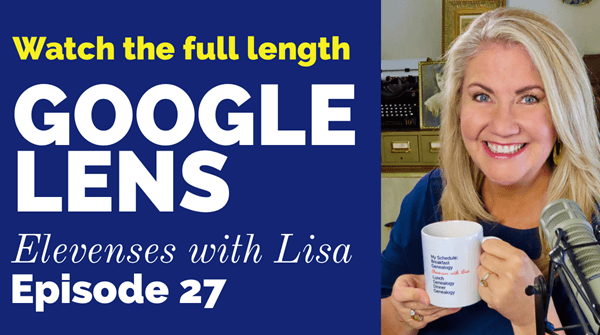
Google Lens with Lisa Louise Cooke
What is Google Lens?
Google Lens is a free technology that Google says helps you ”search what you see.” It uses the latest in Optical Character Recognition (OCR) and artificial intelligence to accomplish tasks.
In this video and article we’ll discuss where you can get Google Lens and how to use it for a wide variety of tasks.
Hang on tight to your phone and let’s jump in!
Google Lens is in Google Photos
Google Lens is doing much of the work in Google Photos. It can detect the faces in your photos, and allow you to search by face. It can also detect objects and text, making it a super fast way to search the photos and images you store in Google Photos.
If you’re not interested in storing all of your photos on Google Photos, that’s OK. As a genealogist, you could still use it for more strategic purposes. You could use it just for family history photos and related genealogical images like documents and photos of tombstones. All of the content you add can then be quickly and easily searched for and found. It can even help you identify a known ancestor in other photos where you may not have recognized it was the same person.
We will talk about specific ways to use Google Lens in Google Photos. But first, let’s talk about all of the ways you can get your hands on Google Lens.
Where can I find Google Lens on my phone or tablet?
Google Lens is available on most mobile devices but not all. Some Samsung devices don’t currently support it. Here’s where you can find Google Lens.
Google Lens is built into Google Photos – Download the Google Photos app to your phone. Pull up one of your photos and look for the Lens icon at the bottom of the screen. If it is there, your phone supports Google Lens.
Google Lens in the Google Search app – You will see the Lens icon in the search bar if your phone supports Google Lens.
The Google Lens app – On Android devices look for the Google Lens app in the Google Play app store.
Where can I find Google Lens on my computer?
Google Lens is primarily a mobile tool although Google Lens is built into the functionality of Google Photos. (It works behind the scenes – you won’t find a Google Lens icon.)
However, you can use your phone to user Google Lens to capture text and then send it to the Chrome browser on your desktop computer.
Using Lens in the Google Photos App
To use Google Lens on your photos in the Google Photos app, you’ll first need to give the app permission to receive the photos you take with your phone. You can then open the Google Photos app and select a photo. In this episode I used the example of a potted plant (Image A below).
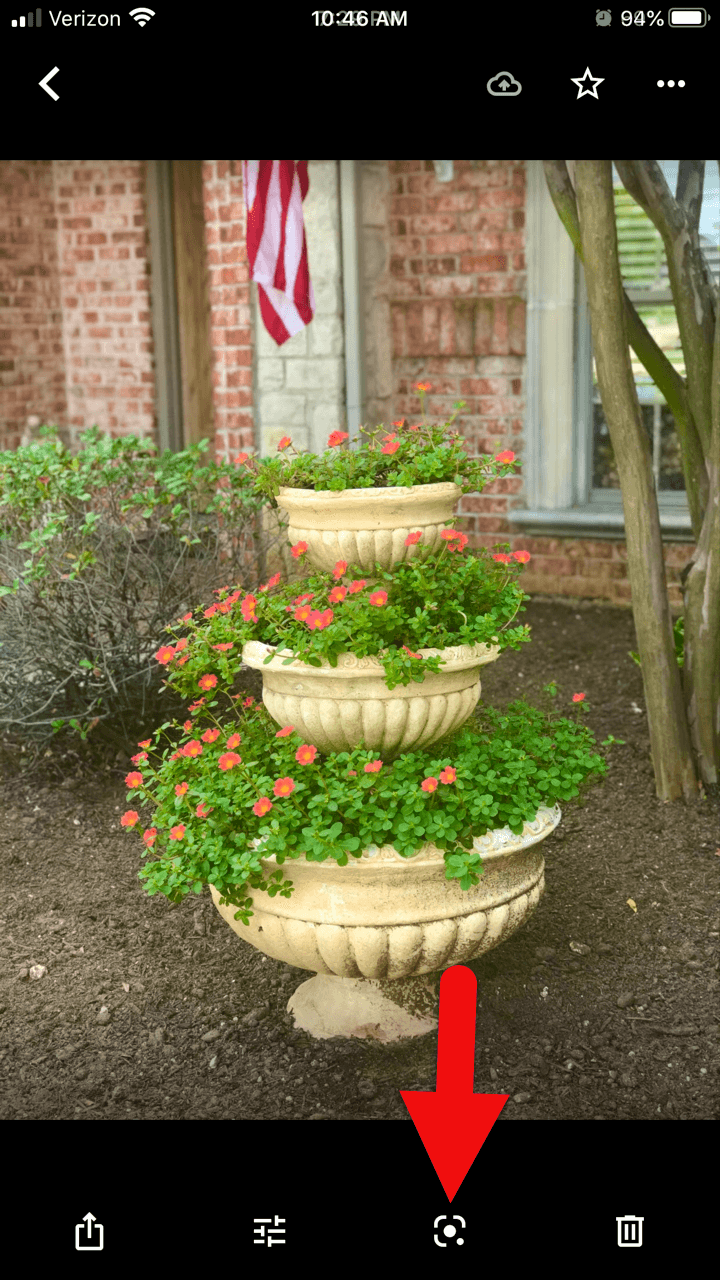
(Image A) Google Lens in the Google Photos app
Tap the Google Lens icon at the bottom of the screen and you will receive search results that include the name of the plant, photo examples of the same plant, possible shopping options, and web pages providing more information about that plant.
Here’s another way you can use the Google Lens feature in the Google Photos app:
- Take a photo of a business card. (I used Google’s PhotoScan app to do this. The app does a great job of removing glare and other distortions that can occur when you photograph something with your phone. You can download the free Google PhotoScan app from your device’s app store.)
- Access the photo in the Google Photos app.
- Tap the Google Lens icon.
- Lens turns the information on the card into actionable buttons:
- Add to contacts
- Call now
- search on the web
- go to the website
Google Lens is in the Google Search app
On many mobile devices such as the iPhone (but not all devices) the Google Lens icon will appear in the search bar. If you’re not sure if you already have the Google Search app on your phone, go to the app store app on your phone and search for “Google Search.” You will see the app listed with a button that either says “Open” (because it is already on your phone) or “Install” (because it is not yet on your phone.)
You can also check to see if they app is on your phone by searching for “Google Search” in the search bar of your phone.
Here’s what the Google Search app looks like on a phone (Image B below):
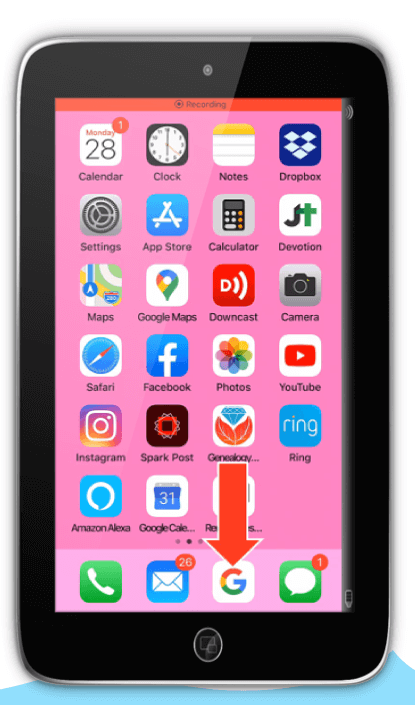
(Image B) Look for the Google Search app on your phone.
The Google Lens App
If you have an Android phone, search the Google Play store for the Google Lens app. Here’s what the app looks like (Image C below):
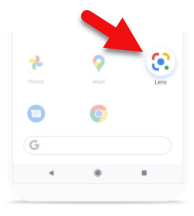
(Image C) Android users with phone’s supporting Google Lens will find the app in the Google Play app store.
What Google Lens Can Do
Once you start using Google Lens the possibilities for its use can seem endless. Here’s a list of the kinds of things Google Lens can do:
- Shopping
- Identify Objects
- Copy Text from printed materials or objects
- Search for Text on printed material or objects
- Solve math problems
- Read text to you
- Translate text
How to Use Google Lens to Read a Book
Before you buy that next history book or go through the trouble of requesting it through inter-library loan, why not let Google Lens determine if it is already available for free online? This next tip works really well for old books that are likely to be in the public domain or printed before 1924.
- Open the book to the title page
- Open the Google Search app on your phone
- Tap the Google Lens icon
- Hold your phone over the title page
- Tap the search button
- If the book is available on Google Books, the title will appear along with a blue “Read” button
- Tap the “Read” button to access, read and search the book on Google Books for free!
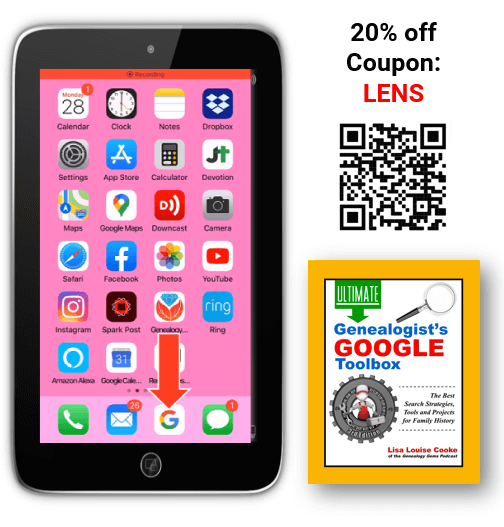
(Image D) Point your phone’s camera or Google Lens at the QR code
Open the camera on your phone and point it at the QR code above (Image D) to be taken to the book in the Genealogy Gems store.
Use coupon code LENS to get 20% off!
Resources
Premium Video & Handout: Solving Unidentified Photo Album Cases. (This video features using Google Photos.)
Book: The Genealogist’s Google Toolbox by Lisa Louise Cooke. (Includes search strategies, Google Photos, and Google Translate.)
Bonus Download exclusively for Premium Members: Download the show notes handout
Answers to Your Live Chat Questions
One of the advantages of tuning into the live broadcast of each Elevenses with Lisa show is participating in the Live Chat and asking your questions.
From Rosalyn: Lisa are the old photos hanging on your wall the originals or copies? They are very nice.
Lisa’s Answer: I always put copies in frames when I hang them on the wall because light can fade originals. They are all my family.
From Jn Rollins: Does it do the same identification for birds?
Lisa’s Answer: I haven’t snapped a photo of a bird, but I’m sure it could. I used it on a photo of a bird, and it identified it perfectly.
From Susan: I have to download an app to get the lens icon?
Lisa’s Answer: If you have an Android phone, you may be able to download the free Google Lens app from your app store. Otherwise, you will find the icon in the Google Search app or the Google Photos app on supported devices.
From Patriva: Is Google Go the same as Google Search?
Lisa’s Answer: Google Go is a “lighter faster” search app. I think it may be geared more toward Samsung devices. I have a Samsung Tab and it doesn’t support Google Lens.
From Carrie: Does this work with the Google Chrome app?
Lisa’s Answer: The Chrome app doesn’t have the Google Lens icon.
From Jn Rollins: I installed Lens a while ago on my Android phone, but when I open Google search the lens icon doesn’t appear next to the microphone icon. How can I change that?
Lisa’s Answer: Some Android devices (like Samsung phones) don’t support Google Lens so you won’t see the icon. Check the app store to see if they offer the Google Lens app for your phone. However, I’m guessing it probably won’t be offered since it sounds like your phone doesn’t support Google Lens.
From Christine: I love this technology for speeding up research! But I have some reservations—what privacy are we giving away? How will Google use our search history?
Lisa’s Answer: I would not use Google Lens for anything I consider “sensitive.” Go to the privacy settings in your Google MyActivity to learn more.
From Lynnette: Can you put the text into Evernote easily?
Lisa’s Answer: Absolutely! Tap to copy the detected text, open an Evernote note, press your finger in the note and tap Paste to paste the text.
From Colleen: I see you are google searching. Does doing this with photos allow others to access my google photos when searching for an item? For example, the example you used with the purse?
Lisa’s Answer: To the best of my knowledge your photos are not searchable by others online. However, it is possible that Google uses the image internally to “train” the machine learning. Go to the privacy settings in your Google MyActivity to learn more.
From Christine: Lisa, can this be used to compare photos to determine if they are the same person? Thanks for sharing all your wisdom!
Lisa’s Answer: Yes! Watch my Premium membership video called Solving Unidentified Photo Album Cases.
From Caryl: Don’t know what a symbol is on a headstone? Now this would be oh so helpful!!
Lisa’s Answer: Yes, indeed!
From Susan: I quickly took a photo of the book cover, so now I can get your book! Is it better to buy directly from you or go to Amazon?
Lisa’s Answer: The book is available exclusively at my website: https://www.shopgenealogygems.com
From Debbie: Will FamilySearch’s app be independent, or will it work / integrate with Google?
Lisa’s Answer: FamilySearch would not be integrated. However, as handwriting technology is developed I’m sure you’ll find it in use in both places.
Please Leave a Comment or Question
I really want to hear from you. Did you enjoy this episode? Do you have a question? Please leave a comment on the video page at YouTube or call and leave a voice mail at (925) 272-4021 and I just may answer it on the show!
If you enjoyed this show and learned something new, will you please share it with your friends? Thank you for your support!
How German Address Books at Ancestry.com are Helping Bust Brick Walls
My genealogy research looks a lot like yours. Some family tree lines go back to pre-Revolutionary War. Other lines are richly researched well into the early 19th century.
And then there’s THAT family line. You know the one I mean. The one where the courthouse containing the records we need has burned down, or the records were microfilmed ages ago but are still sitting in the FamilySearch granite vault due to copyright issues. Or worst of all, it appears the needed records just don’t exist.
Don’t let these obstacles allow you to give up hope.

Every day, new records are being discovered and digitized. Records that have been languishing in a copyright stalemate might suddenly be cleared for publication. Or a cousin could contact you out of the blue and has the letters your grandmother sent hers. We never know when the records we’ve been waiting for, searching for, and yearning for, will bubble up to the surface.
Today I’m happy to share my story of a recent breakthrough that I never saw coming. Follow along with me as I take newly unearthed rocks and use tools to turn them into sparkling gems.
This is Almost Embarrassing
My one, agonizing family line that stops short in its tracks ends with my great grandfather Gustave Sporowski.
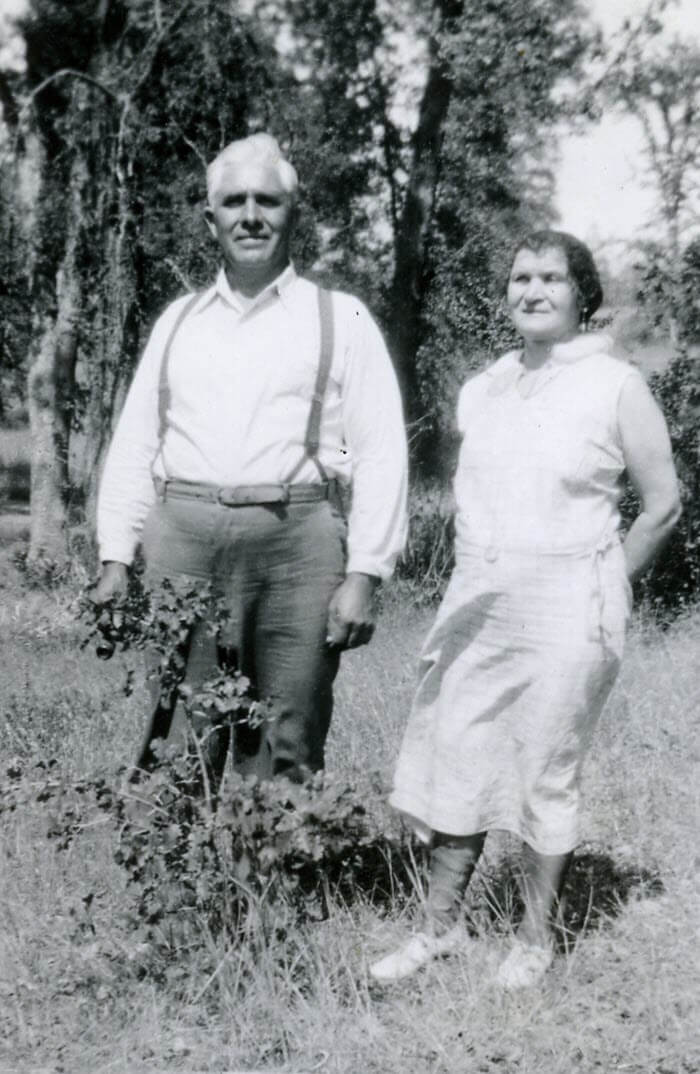
Gustave and Louise Sporowski (personal collection)
It’s almost embarrassing to admit. I’ve been at this nearly my whole life, and genealogy is my career for goodness sake! But there it is, a family tree with lovely far-reaching limbs except for this little stub of a branch sticking out on my maternal grandmother’s side.
I was about eight years old the first time I asked my grandma about her parents and their families. (Yes, this genealogy obsession goes back that far with me!) I still have the original page of cryptic notes she scratched out for me during that conversation.

Excerpt from Grandma’s original notes. (Personal collection)
She had several nuggets of information about her mother’s family. However, when it came to her father Gustave, she only recalled that he was the youngest of seven brothers. No names came to mind. I’ve always felt that if I could just identify some of the brothers, one of them may have records that provide more details about their parents.
According to his Petition for Naturalization, Gustave Sporowksi and Louise Nikolowski were married in LutgenDortmund, Germany. This indicated that both moved west from East Prussia before emigrating. While I knew Louise’s immediate family were in the LutgenDortmund area as well, I had no idea whether Gustave moved there on his own or with his family.
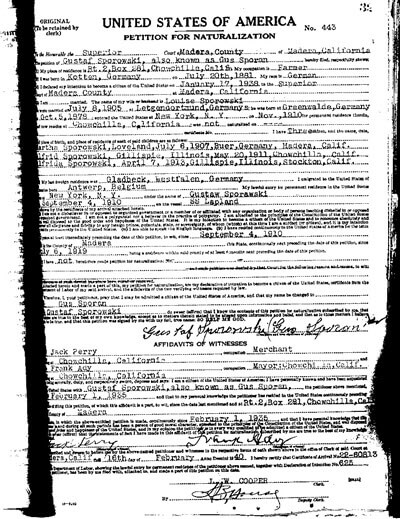
Gustave Sporowski’s Petition for Naturalization.
Gus (as he was later known) emigrated from Germany in 1910, landing at Ellis Island. He toiled in the coal mines of Gillespie, Illinois, and eventually earned enough money to move his wife and children west to California in 1918.
After filing his papers and years of waiting, he proudly became a U.S. citizen in 1940.
On that paperwork, he clearly states his birthplace as Kotten, Germany. You won’t find this location on a map today. In 1881, the year he was born, the area was East Prussia. I remember the hours I spent with gazeteers many years ago trying to locate that little village nestled just within the border of Kreis Johannisburg. Being so close to the border meant that he could have attended church there or in a neighboring district.
The records in the area are scarce, and today the entire area is in Poland.
Surprisingly, the records situation is quite the opposite with his wife Louise, also from East Prussia. She lived not far away in Kreis Ortelsburg, and the records for the church her family attended in Gruenwald are plentiful. I’ve managed to go many more generations back with her family.
And so, poor Gus alone sits in my family tree.
I periodically search to see if there’s anything new that has surfaced, but to no avail. I even hired a professional genealogical firm to review my work and suggest new avenues. I guess it is good news to hear you’ve pursued all known available leads, but it’s not very rewarding.
Over time, we tend to revisit tough cases like this less frequently. They become quiet. Digital dust begins to settle on the computer files.
And then it all changes.
German Address Books at Ancestry.com
I regularly make the rounds of the various genealogy websites, making note of new additions to their online collections. I typically publish the updates on a weekly basis here on the Genealogy Gems blog. It makes my day when readers like you comment or email, bursting with excitement about how one of the collections I mentioned busted their brick wall. I love my job.
This week I’m the one who is bursting!
It started simply enough. My third stop on my regular records round-up tour was Ancestry.com. The list of new records was particularly robust this week. The word “Germany” always catches my eye, and the second item on the list jumped out at me:
Germany and Surrounding Areas, Address Books, 1815-1974
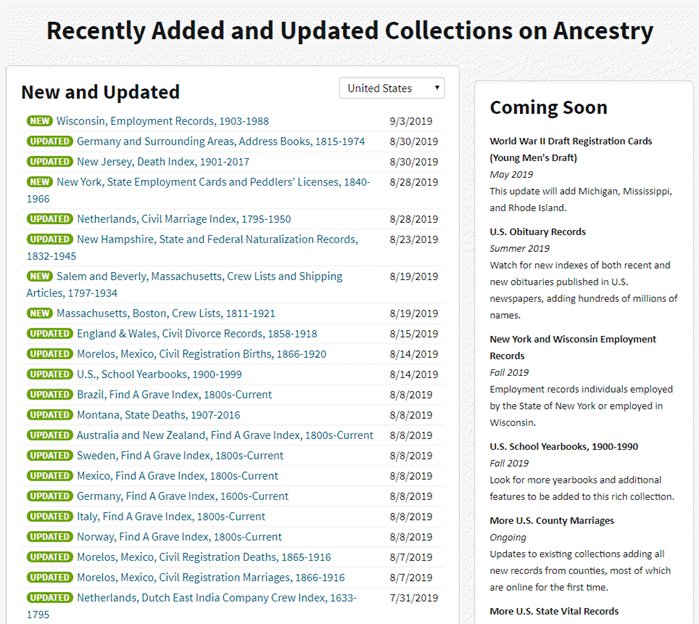
“Recently Added and Updated Collections on Ancestry,” Ancestry.com (http://www.ancestry.com : accessed 05 Sept 2019)
I should have had a healthy dose of skepticism that I would be fortunate enough to find anything. But to be perfectly honest, I felt instinctively that I would! Have you ever just had that feeling that your ancestors are sitting right there ready to be found? If you’ve been researching your family history for a while, then I’m guessing you have. Such a nice feeling, isn’t it?
So, I clicked, and I simply entered Sporowski in the last name field and clicked Search.
Experience has taught me that there haven’t been a lot of folks through history with this surname, so I’m interested in taking a look at anyone who pops up in the results. And yippie aye oh, did they ever pop up!
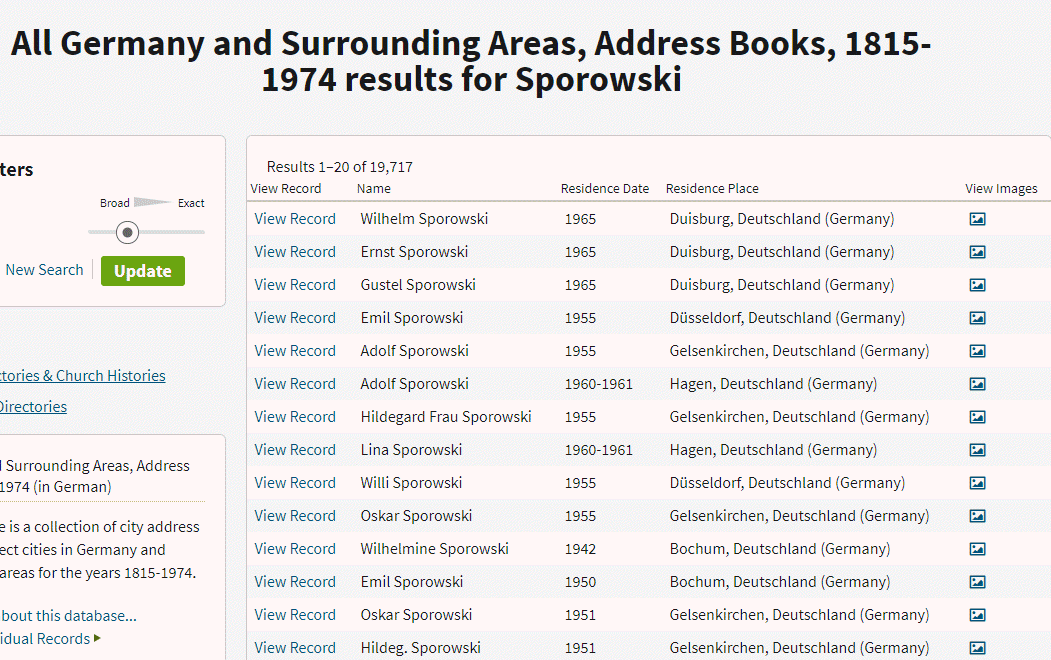
“All Germany and Surrounding Areas, Address Books, 1915-1974,” Ancestry.com (http://www.ancestry.com : accessed 05 Sept 2019)
The results list include 31 people with the surname of Sporowski!
These names came from the pages of address books much like the city directories so common in the U.S. Since this collection was new to me, I took a moment to read up on the history.
______________________________
GENEALOGY RESEARCH TIP: Learning the History of the Genealogy Record Collection
To truly understand what you are looking at when reviewing search results, we need to acquaint ourselves with the history of the collection.
- Why was it created?
- What does it include?
- What does it not include?
Look to the left of the search results and click Learn more about this database.
It’s definitely worth clicking this link because the next page may also include a listing of Related Data Collections, some of which you might not be aware. These could prove very useful, picking up the pace to finding more records.
In the case of foreign language records, look for a link to the Resource Center for that country. There you may find translation help and tips for interpreting handwriting and difficult-to-read script.
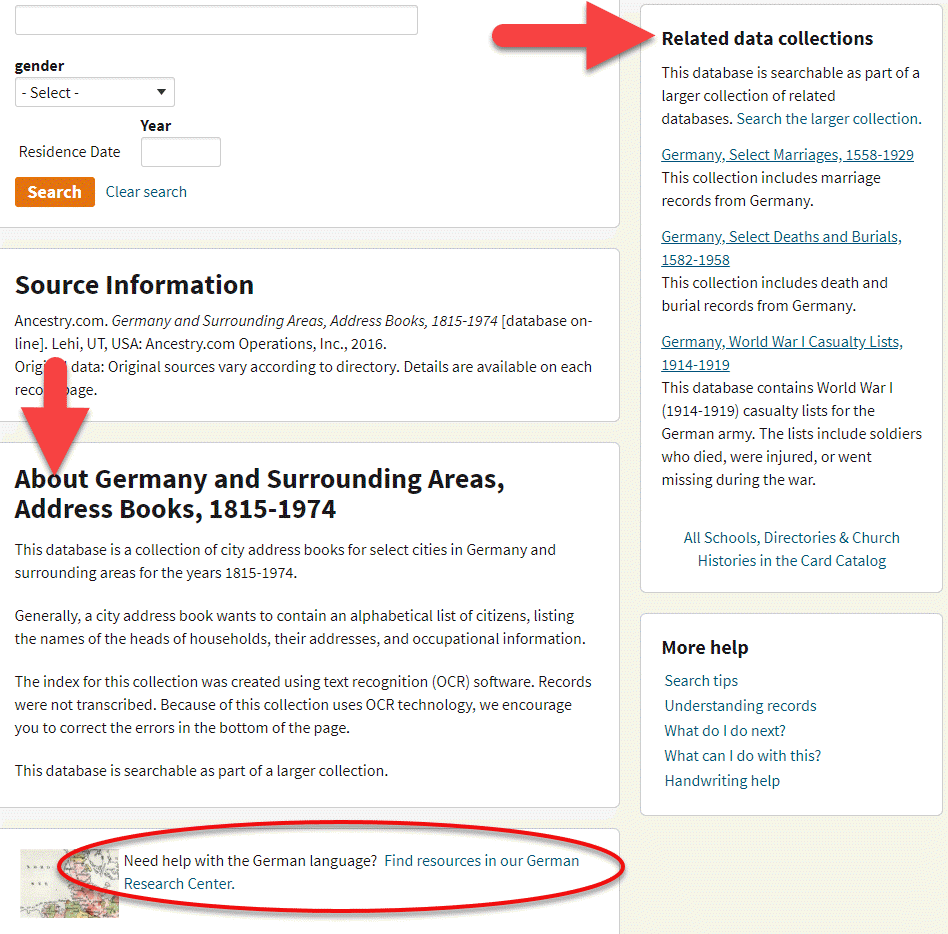
Ancestry Help Features
______________________________
On the Learn more about this database page, I learned some important things about these search results.
First, not every citizen was listed. Only heads of households were included. This means that wives and children would not appear. I did find some widows, though, because they were the head of their household.
Second, Optical Character Recognition (OCR) was used on this collection. Ancestry suggests looking for errors and providing corrections. But this information about OCR also implies something even more important to the genealogist. We must keep in mind that OCR is not perfect. In this case, I planned on browsing the collection after reviewing the search results to ensure I didn’t miss anyone. This would include targeting people listed in the “S” section of directories for towns I might expect the family to be.
I was particularly thrilled to see the name “Emil Sporowski” on the list.
Several months ago I found a World War I Casualty list from a newspaper published in 1918.

On it was listed Emil Sporowski and he was from the village of Kotten. This was the first mention of Gustave’s birthplace in the record of another Sporowski that I had ever found. So, you can imagine my delight as I stared at his name in the address book search results.
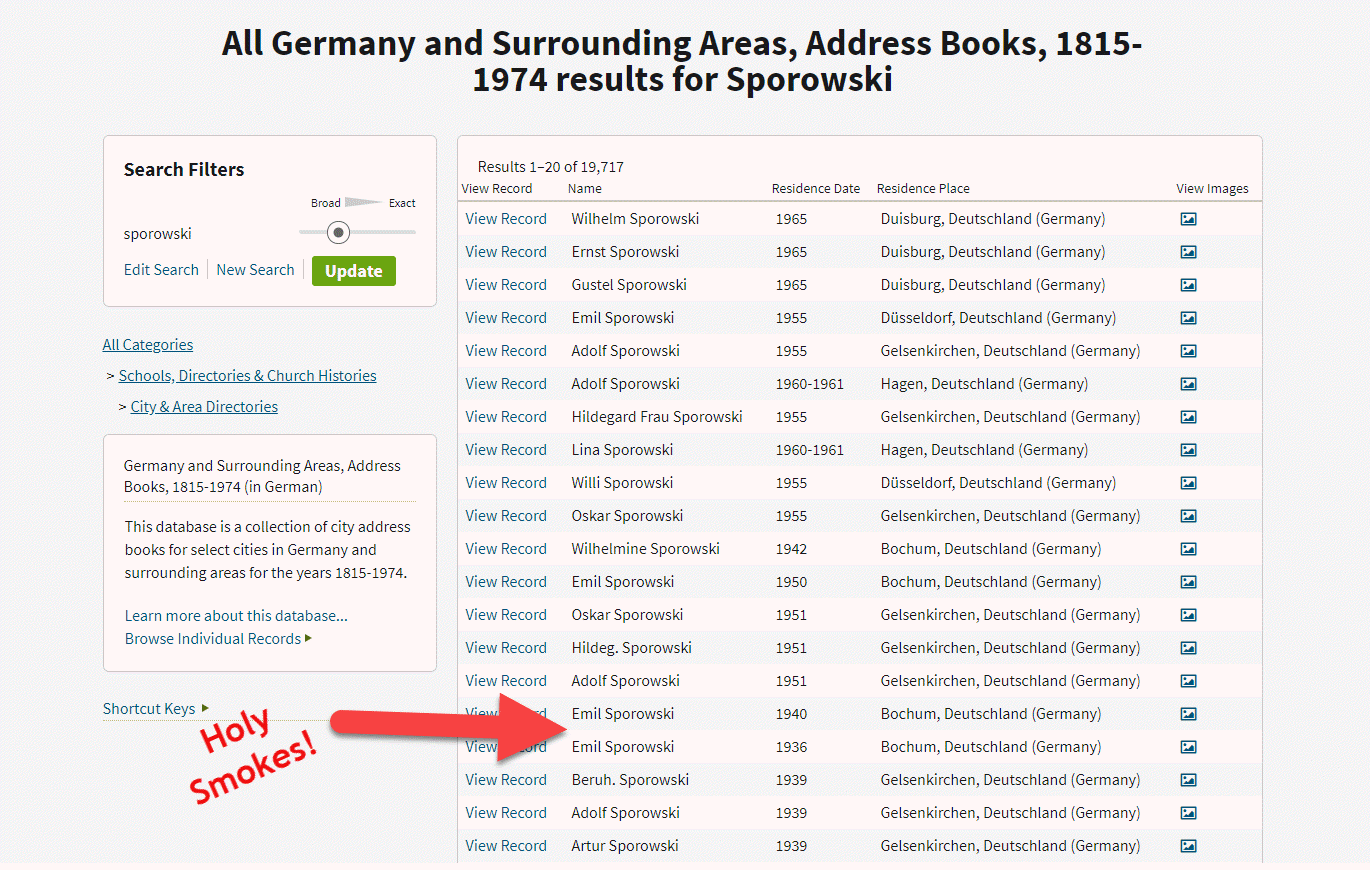
“All Germany and Surrounding Areas, Address Books, 1915-1974,” Ancestry.com (http://www.ancestry.com : accessed 05 Sept 2019)
The icing on that cake was that he was listed in the address book of Bochum. That town name was very familiar to me because I had seen it on a few old family photos in Louise Sporowski’s photo album. Although the photos did not have names written on them, I could easily identify the folks who had the facial characteristics of Louise Nikolowski’s clan, and those sporting the large eyes with heavy lids like Gus.
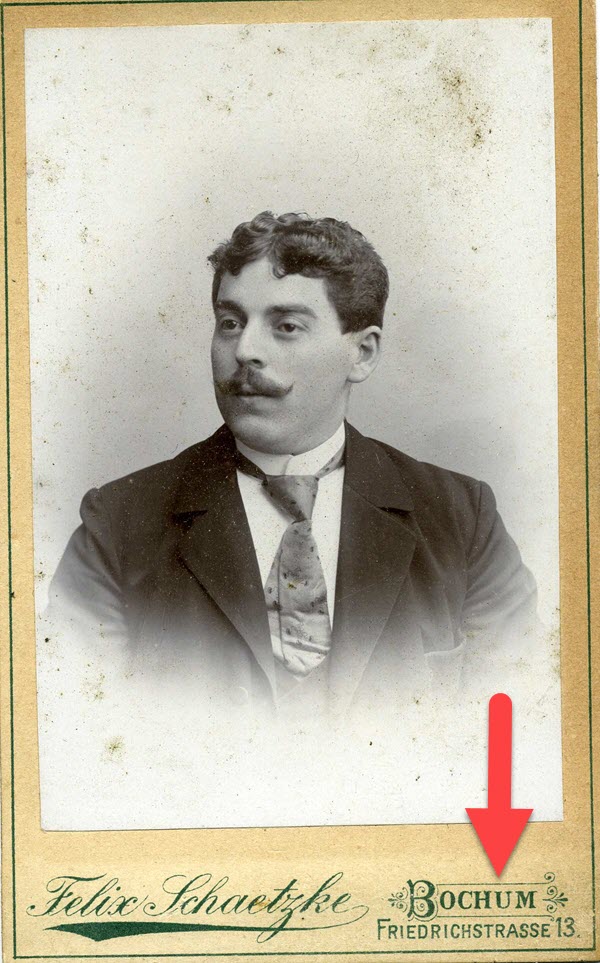
Photo from Louise Nikolowski’s photo album.
Spreading the German Addresses Out with Spreadsheets
With one and a half pages delivering a total of 31 Sporowski names, I knew I had some work ahead of me to tease them apart. This got me thinking of Genealogy Gems Podcast episode that I’m currently working on, which features a conversation with professional genealogist Cari Taplin. When I asked Cari how she organizes her data, she told me that she uses spreadsheets. I’m not typically a spreadsheet kind of gal, but in this case, I could see the benefits. Spreadsheets offer a way to get everybody on one page. And with the power of Filters and Sorting you slice and dice the data with ease. My first sort was by town.
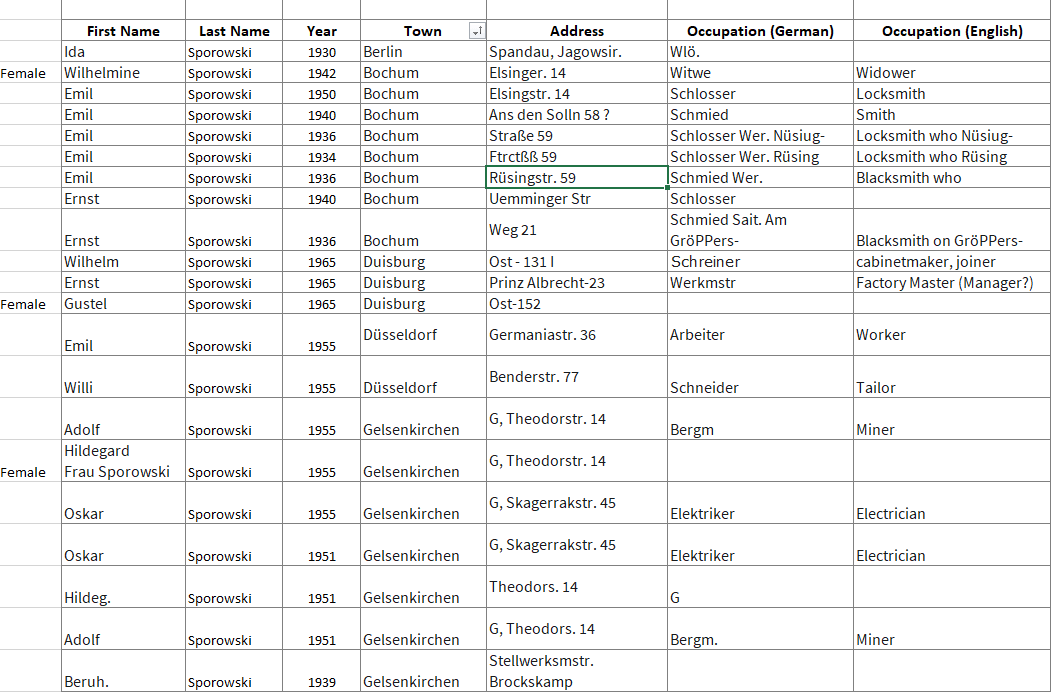
My Excel spreadsheet tracking German Address Books search results at Ancestry.com
______________________________
GENEALOGY RESEARCH TIP: Free Genealogy Gems Download
Click here to download the simple yet effective spreadsheet I used for this research project. If you find your German ancestors in this collection, it’s ready to use. Otherwise, feel free to modify to suit your needs in a similar situation.
______________________________
As you can see in the spreadsheet, these address books include occupations. For example, Emil was listed both as a Schmied and a Schlosser. A simple way to add the English translation to my spreadsheet was to go to Google.com and search Google Translate. Words and phrases can be translated right from the results page.
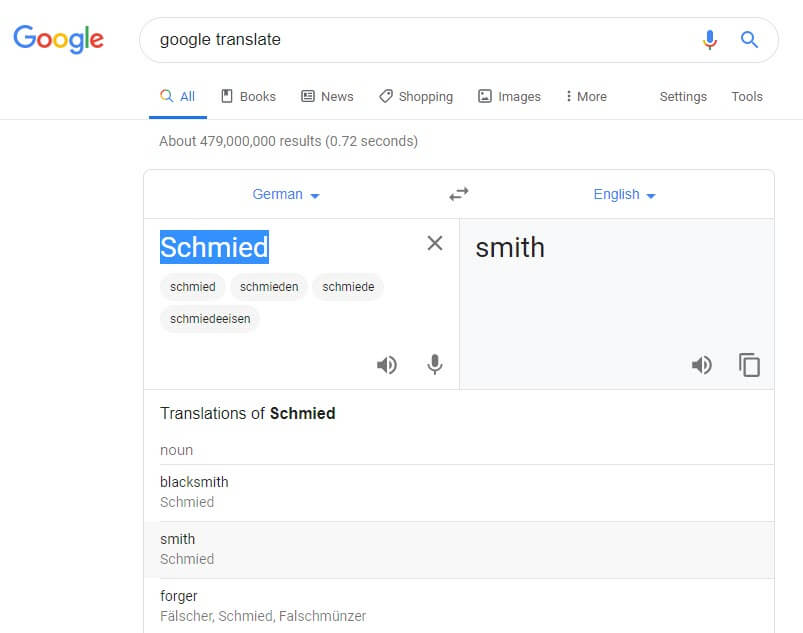
Translating the Occupation found in the German Address Books using Google Translate (Available at https://translate.google.com. Accessed 05 Sept 2019)
You can also find several websites listing German occupations by Googling old german occupations.
I quickly ran into abbreviations that were representing German words. For example, Lina Sporowski is listed with as Wwe .
A Google search of german occupations abbreviations didn’t bring a website to the top of the list that actually included abbreviations. However, by adding one of the abbreviations to the search such as “Wwe.” it easily retrieved web pages actually featuring abbreviations.
One of the top results was by friend of the podcast Katherine Schober and her SK Translations blog post called 19 Most Common Abbreviations in German Genealogy.
______________________________
GENEALOGY RESEARCH TIP: Use Search Operators when Googling
Notice that I placed the abbreviation in quotation marks when adding it to my Google search query. Quotation marks serve as search operators, and they tell Google some very important information about the word or phrase they surround.
- The quotation marks tell Google that this word or phrase must appear in every search result. (If you’ve ever googled several words only to find that some results include some of the words, and other results include others, this will solve your problem.)
- They also tell Google that the word(s) MUST be spelled exactly the way it appears on each search result. This is particularly helpful when searching an abbreviation like Wwe. which isn’t actually a word. Without the quotation marks, you will likely get a response from Google at the top of the search results page asking you if you meant something else.
Click here to receive my free ebook including all the most common Google search operators when you sign up for my free newsletter (which is always chock full of goodies).
______________________________
Katherine was my guest on Genealogy Gems Premium Podcast Episode #151 available exclusively to our Premium eLearning Members. She’s also written a couple of articles for Genealogy Gems on German translation:
When to Use Google Translate for Genealogy–And Best Translation Websites for When You Don’t
Translating German Genealogy Records: 9 Top German Translation Websites
Deciphering Place Names Just Got Easier
I’ve written an article you may find helpful not only for translation but also to help you with pronunciation called How to Pronounce Names: Google Translate and Name Pronunciation Tools.
As it turns out, Wwe. stands for Widow. This tells me that Lina’s husband was deceased by 1961.
Finding the German Addresses in Google Earth
The most glorious things found in these old address books are the addresses themselves!
Google Earth is the perfect tool to not only find the locations but clarify the addresses. Many were abbreviated, but Google Earth made quick work of the task.
Unlike other free Google Tools, Google Earth is available in a variety of forms:
- Free downloadable software
- Google Earth in the Chrome Web browser
- A mobile app
Each has powerful geographic features, but I always recommend using the software. The web version and app don’t have all the tools available in the software. All versions require an internet connection. You can download the software here.
In the Google Earth search box I typed in the address. Don’t worry if you don’t have the full address or if you think it may be spelled incorrectly. Google Earth will deliver a results list of all the best options that most closely match.
In my case, reliable Google Earth not only gave me complete addresses, but also the correct German letters.
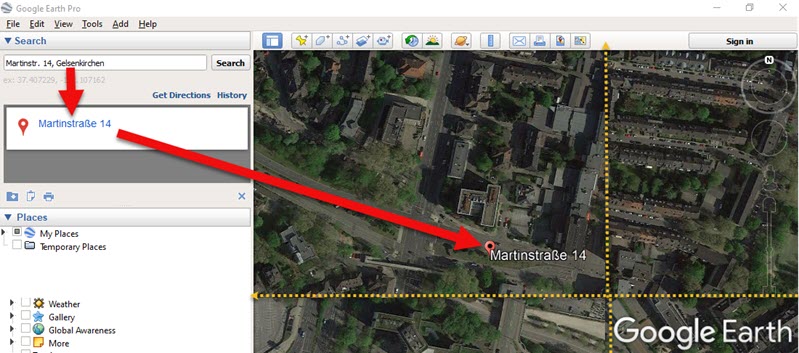
Finding the full name of the German address. (Map data ©2019 Google Earth software: accessed 6 Sep 2019)
Soon I found myself virtually standing outside their homes thanks to Google Earth’s Street View feature!
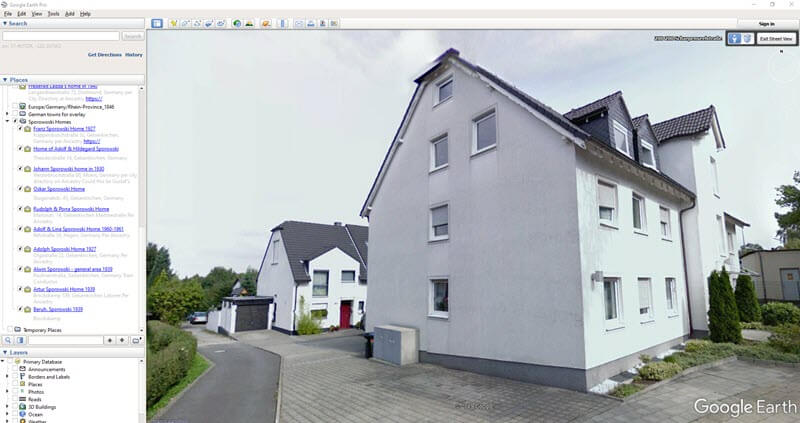
Home of my German ancestor found in Google Earth in Street View. (Map data ©2019 Google Earth software: accessed 6 Sep 2019)
Here’s how to use Street View in Google Earth:
- Zoom in close to the location
- Click on the Street View icon in the upper right corner (near the zoom tool)
- Drag the icon over the map and blue lines will appear where Street View is available
- Drop the icon directly on the line right next to the house
- Use the arrow keys on your keyboard to navigate in Street View or simply use your mouse to drag the screen
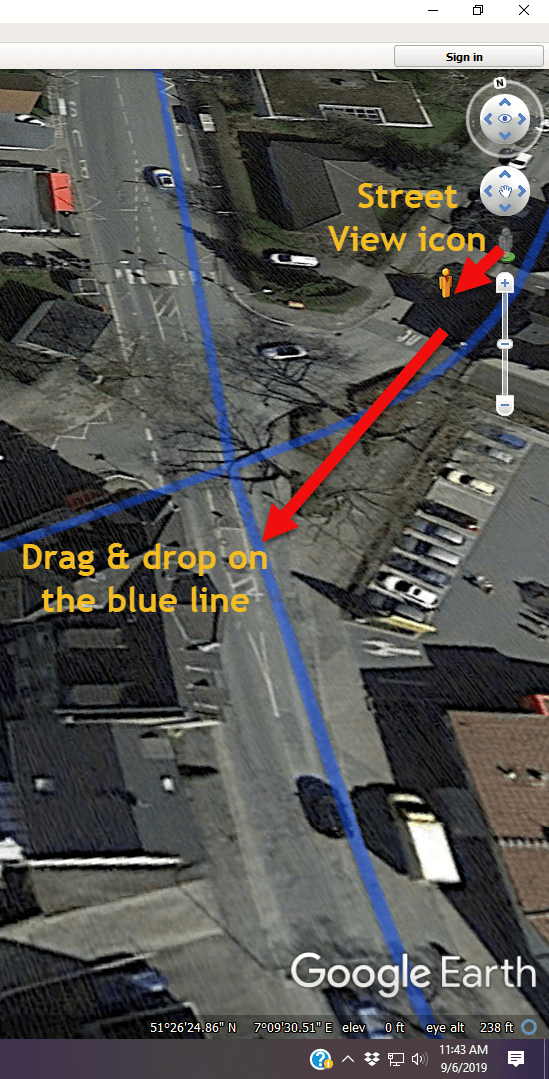
Using Google Earth Street View. (Map data ©2019 Google Earth software: accessed 6 Sep 2019)
I went through the entire list. As I found each location in Google Earth, I checked it off on the spreadsheet.
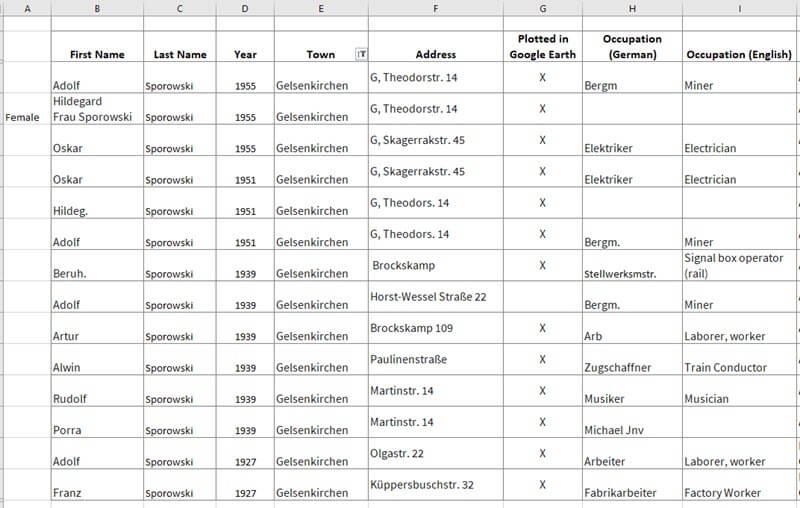
Addresses found in German Address Books at Ancestry.com marked in the spreadsheet
GENEALOGY RESEARCH TIP: Create a Folder in Google Earth
When you have several locations like this to plot, I recommend creating a folder in the Places panel in Google Earth. It’s super easy to do and will help you stay organized. Here’s how:
- Right-click (PC) on the MyPlaces icon at the top of the Places panel (left side of the Google Earth screen)
- Select Add > Folder in the pop-up menu
- A New Folder dialog box will appear
- Type the name of your folder
- Click OK to close the folder
- You can drag and drop the folder wherever you want it in the Places panel
- Click to select the folder before placing your Placemarks. That way each placemark will go in that folder. But don’t worry, if you get a placemark in the wrong spot, just drag and drop it into the folder.
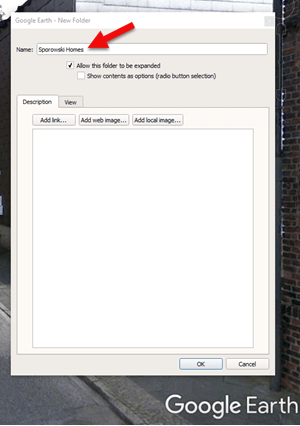
Creating a Folder for the German Addresses found at Ancestry.com (Map data ©2019 Google Earth software: accessed 6 Sep 2019)
It didn’t take long to build quite a nice collection of Sporowski homes in Germany!
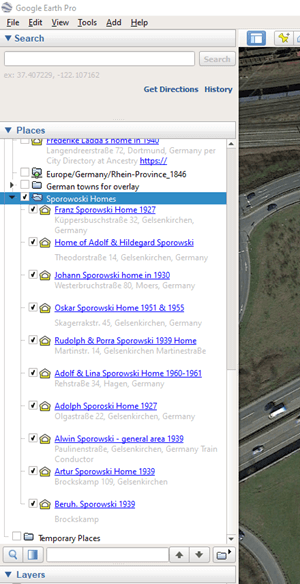
German addresses in the Places panel. (Map data ©2019 Google Earth software: accessed 6 Sep 2019)
The beauty of Google Earth as that you can start to visualize your data in a whole new way. Zooming out reveals these new findings within the context of previous location-based research I had done on related families. As you can see in the image below, all the Sporowskis that I found in the German Address books at Ancestry.com are clustered just five miles from where photos were taken that appear in Louise Sporowski’s photo album.

Data Visualization in Google Earth: My German Families found in Address Books. (Map data ©2019 Google Earth software: accessed 6 Sep 2019)
I’ve Only Just Begun to Discover my German Ancestors at Ancestry.com
We’ve covered a lot of ground today, but this is just the beginning. There are additional sources to track down, timelines to create, photos to match up with locations, and so much more. In many ways, I’ve only scratched the surface of possibilities. But I need to stop writing so I can keep searching! 😊
I hope you’ve enjoyed taking this journey with me. Did you pick up some gems along the way that you are excited to use? Please leave a comment below! Let us all know which tips and tools jumped out at you, and any gems that you found.

